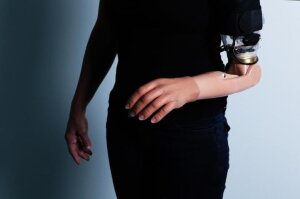por
Lauren Dubinsky, Senior Reporter | November 01, 2017

An amputee fitted with an advanced
arm prosthetic after TMSR surgery
Researchers in Switzerland recently mapped the brains of patients with prosthetic limbs using 7T functional MR technology.
“The kind of prostheses tested in the study (as almost all existing devices) lacks sensory feedback,” Andrea Serino of the University Hospital of Lausanne, told HCB News. “They do not provide tactile information when the robotic hand touches something, or proprioceptive information about the location of the limb in space. These are critical for the normal experience of the body.”
A procedure called targeted motor and sensory reinnervation reroutes residual limb nerves toward intact muscles and skin in order to fit them with a limb prosthesis and enable unprecedented control. The success of TMSR hinges on scientists’ ability to understand how the brain re-maps the pathways.



Ad Statistics
Times Displayed: 101608
Times Visited: 6232 MIT labs, experts in Multi-Vendor component level repair of: MRI Coils, RF amplifiers, Gradient Amplifiers Contrast Media Injectors. System repairs, sub-assembly repairs, component level repairs, refurbish/calibrate. info@mitlabsusa.com/+1 (305) 470-8013
In a new study published in
Brain, Serino and her team leveraged ultra-high field 7T fMR to better understand this. They focused mainly on the primary motor cortex, somatosensory cortex and regions processing more complex brain functions.
To date, the team has successfully mapped changes in those brain pathways for three patients with upper-limb amputations who underwent TMSR and were proficient with their prosthetic limbs. The motor cortex maps of the amputated limbs were similar in terms of extent, strength and topography to individuals who haven’t lost a limb.
However, the TMSR patient maps were different from the non-TSMR patient maps. The team concluded that these findings highlight the unique impact of TMSR on the brain’s motor map.
The study also showed that TSMR is in need of improvement. The connections between the primary sensory and motor cortex were as weak in the TMSR patients as in the non-TSMR patients, compared to healthy subjects.
That suggests that even though TMSR-powered artificial limbs have good motor performance, they still don’t move and feel like a real limb and the patient’s brain doesn’t recognize them as real limbs. To fix this, the team believes future TMSR prosthetics should incorporate systematic somatosensory feedback and link it to the robotic hand movements.

